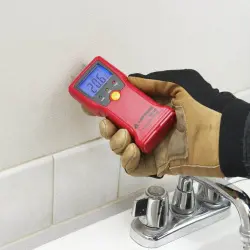Water Quality pH, ORP / Moisture Meters
pH and ORP are important parameters of water quality and a wide range of process applications depend upon the ability to measure and control each. Though measuring very different things, both pH and ORP share a close relationship and are often included together while discussing water quality. Conductivity, resistivity, salinity, and TDS meters are a class of instruments that measure the specific conductance of ions dissolved in solution as a means to analyze water quality. Though each instrument measures a different water quality parameter, all shares a strong correlation which allows them to all use conductivity as the measuring principle with resistivity, salinity and TDS values are calculated from conductivity readings.
Moisture Meters check the moisture content of building materials for water damage or harmful mold growth, using a moisture meter.
Moisture Meters check the moisture content of building materials for water damage or harmful mold growth, using a moisture meter.
pH stands for "potential of hydrogen" and is a measure of hydrogen ion concentration. A high concentration of hydrogen ions results in acidity while a low concentration results in alkalinity. The concentration of hydrogen ions is represented on a scale from 0 to 14 with 7 being neutral (i.e. an equal number of hydrogen (+) ions and hydroxide (-) ions to cancel each other out). Values below pH 7 are acidic and values above pH 7 are alkaline. The scale is logarithmic, meaning each full point increases or decreases by a factor of 10x. Some extreme substances can score lower than 0 or greater than 14, but most fall within the scale.
pH measurements are important in medicine, biology, chemistry, agriculture, forestry, food science, environmental science, oceanography, civil engineering, chemical engineering, nutrition, water treatment & water purification, and many other applications.









